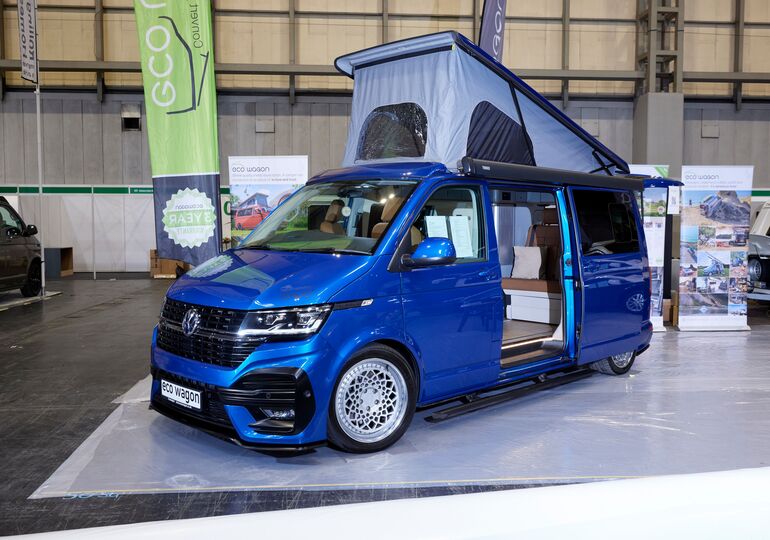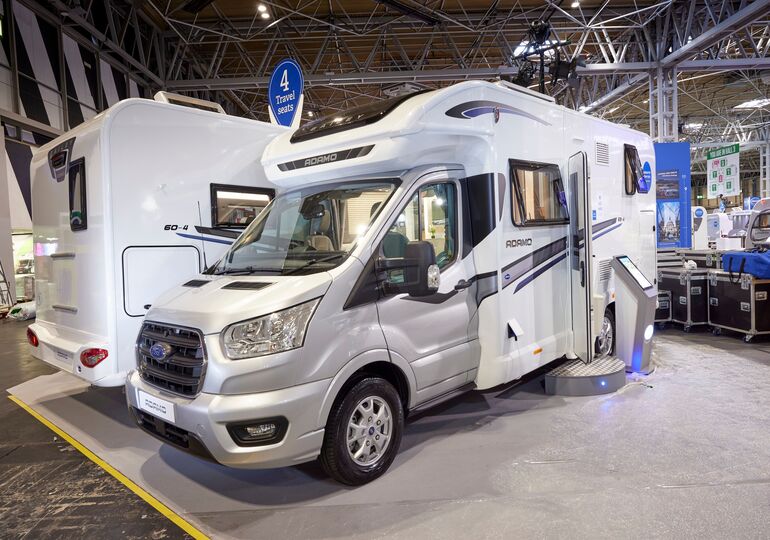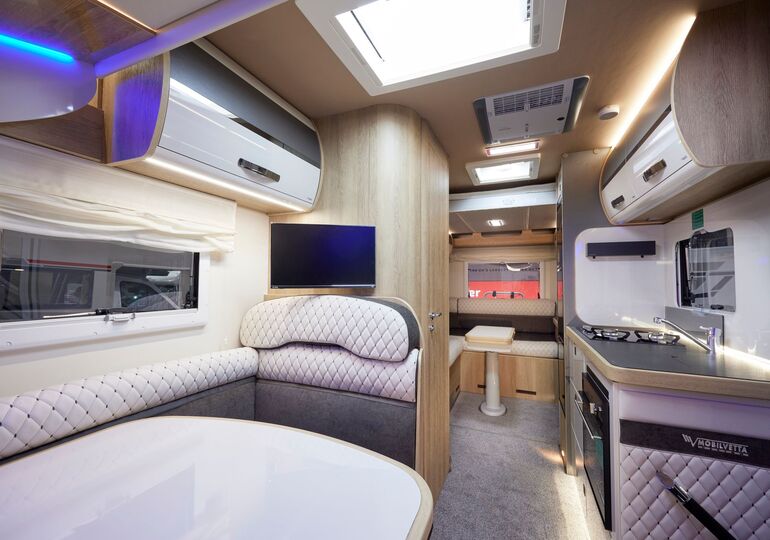Dan Cartwright has over 12 years of experience in the caravan and motorhome industry. He is a judge for a number of prestigious leisure vehicle awards and regularly heads off in his motorhome with his family. Every week, Dan shares his insights with the community. Here’s what he has to say this week.
This week, I was at the Caravan and Motorhome Club Motorhome & Campervan Design Awards 2023 to judge the best vehicles in each category. For those not familiar, this is the industry-leading awards show, scrutinised by seven journalists and technical experts on the judging panel.
A combined 28 weeks of research and physical inspection are put into the awards. Each judge has their own specialism but also votes across the board on aspects like general appeal, practicality and innovation. The results were compiled and discussed in a meeting on the morning of Wednesday 23rd February, with awards being given out to the 14 winners of each different category.
This is a huge commitment and it’s taken extremely seriously. Every single website, handbook and data specification sheet – as well as all 64 entrants – was thoroughly inspected, with no stone left unturned.
What are the awards for?
I’d like to thank the Caravan and Motorhome Club (CAMC) for putting on such a worthwhile event and, as always, it’s been a privilege to be a judge. But most of you may want to know what these awards are for. Well, they’re for CAMC members and anyone interested in the leisure industry – we do some of the leg work so you don’t have to.
When a specific manufacturer wins an award, we’re not saying it’s the only leisure vehicle we’d recommend in that class. Instead, it’s a benchmark for people looking to purchase within that category. Essentially, we’re saying it’s a good one! You might go for something different, but this campervan or motorhome will have everything you need for a good holiday if you want this vehicle size.
The awards are also a recognition of the industry, rewarding innovation, green technology and manufacturers who clearly understand how their leisure vehicles are used. As a panel, we know the plethora of little things that can make your holiday so much easier and more enjoyable, so it’s great to see lots of these being included and driving our industry forward.
So, what have we seen this year? Well, everything! From campervans under five metres to motorhomes based on a double-decker bus layout. Others boasted dishwashers and washing machines, some had eco-friendly lounge insulation – one particular motorhome even had a garage specifically designed to hold a Porsche.
As always, it’s been a lot of fun judging and I’d like to offer a big thank you to my fellow panellists, but one thing really stuck out this year. There was a great mix of manufacturers entering and winning. Our final meeting was possibly the least contentious of all time – we all agreed on who’d won in each category. So, onto the winners…
The 2023 CAMC Motorhome & Campervan Design Awards winners and a quick comment from me
Campervans under five metres: Swift Monza
This Ford-based campervan was part of a hotly-contested category. In truth, there were a number of Ford conversions, but we felt the Monza really hit the nail on the head in terms of being bright, fresh and modern, with all the things you’d need to enjoy a campervan holiday.
Campervans over five metres: Ecowagon Expo+

If you’re in the market for a campervan over five metres, do have a look at the Ecowagon – it’s got everything it possibly could have, from gas suspension and eco-lounge wool insulation to off-road capabilities with battery backups and induction hobs. For something that compact, it’s packed with tech and practicality.
Van conversions with a rising or pop top roof: Adria Twin Sports 600 SPB
A two-time winner in both 2022 and 2023, the action-based layout of the 600 SPB gives you a huge carrying capacity for bikes, paddleboards, surfboards and anything else you’d want to take on your holiday. The pop top offers comfy sleeping accommodation and overall the van conversion is clean, well put together, practical and fully deserving of a double win.
Van conversions with fixed roof under six metres: Auto-Trail V-Line 610 Sport
Now, this maximises living. For those who want a bit more time in their van conversion as opposed to being outside in all weather conditions, the V-Line is a beautiful place to relax and hang out. The rear design is innovative, having a boot on a panel van, and means you can keep all the dirty equipment outside of your habitation area.
Van conversions with fixed roof over six metres: RP Motorhomes Rebellion 2 Front Lounge All Electric Habitation

The scale of innovation in the Rebellion 2 is on another level. There’s a 3D-printed sink and toilet brackets, all-wheel drive, park assist, front and rear camera and absolutely everything you need to go off-grid for sustained periods, with amazing battery technology and even an optional composting toilet – a first for motorhomes.
Two-berth coachbuilt motorhomes under six metres: Auto-Sleeper Nuevo EK
A very compact, coach-built motorhome. Auto-Sleeper clearly uses its own products and knows exactly what you need to enjoy touring. The Nuevo EK is built to a very high specification and if you like this layout, it’s definitely worth a look.
Two-berth coachbuilt motorhomes over six metres: Auto-Sleeper Broadway EL
Again, another stalwart classic from Auto-Sleeper. Whilst the layout is available from other manufacturers, the attention to detail and high specification provides you with most of what you’ll need on a motorhome holiday.
Three or four berth coachbuilt motorhomes under seven metres: Bailey Adamo 69-4

This range has won a lot of awards and the 69-4 is no exception. It has a wonderful blend of European style and good living accommodation with UK specs from British manufacturers, which is proving increasingly popular since its launch a few years ago.
Three or four berth coachbuilt motorhomes over seven metres: Adria Matrix Supreme MB670 SL
This really is a little bit of luxury from Adria. The supreme range is exactly what it sounds like – clean, beautiful and with a very Scandinavian feel. A perfect place to enjoy your holidays.
Five or six berth coachbuilt motorhomes under 7.5 metres: Roller Team Auto-Roller 707

Fitting this many sleeping and seating options into a single motorhome is not an easy task. Roller Team has managed to do it whilst still making it feel light, airy and a lovely place to holiday with your family.
Five or six berth coachbuilt motorhomes over 7.5 metres: Auto-Trail Frontier Scout
Another really solid family layout. The Frontier Scout is at the forefront of design, with the option of different sleeping areas for children to sleep whilst parents relax.
A Class under seven metres: Mobilvetta Teckno Line K-Yacht 80

A truly beautiful, really modern A Class, with a lounging area that demands to be sat in. The K-Yacht 80 offers everything you’d expect from this category.
A Class seven to eight metres: Adria Supersonic 780 SL
Adria launched the SL a few years ago and it has a great feel, with an almost minimalist interior that’s bright and light, but also offers everything you’d want from a super luxury A Class.
A Class over eight metres: MORELO EMPIRE LINER 93LB
If you haven’t seen it, go and have a look. All I can say about this one is that within its category, the EMPIRE LINER was like bringing a gun to a knife fight.
Photo credit: The Caravan and Motorhome Club









